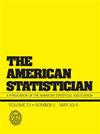通过投注检验贝叶斯模型:贝叶斯p值和经典贝叶斯因子的博弈论替代方案
IF 2.1
4区 数学
Q1 STATISTICS & PROBABILITY
引用次数: 0
摘要
严格的贝叶斯模型由一组可能的数据分布和该集合上的先验分布组成。如果有其他可用的模型,它们预测数据的好坏可以使用贝叶斯因子进行比较。如果不是,则可以使用贝叶斯p值(如先验预测p值或后验预测p值)检查模型。然而,最近对普通p值的批评同样适用于贝叶斯p值。这些批评中的许多都被e值所克服,e值被解释为否定零假设的证据数量,被衡量为反对零假设的回报。本文提出使用e值通过检验贝叶斯模型的先验预测分布作为零假设来检验贝叶斯模型。给出了两种普遍适用的严格检验贝叶斯模型的方法。第一种方法通过将贝叶斯p值转换为贝叶斯e值来校准贝叶斯p值。第二种方法使用贝叶斯因子或它们的近似值作为贝叶斯e值。一个健壮的贝叶斯模型,一组严格贝叶斯模型,可以使用使用这些严格贝叶斯模型的e值的各种函数来检查。其他函数衡量数据在多大程度上支持贝叶斯模型。讨论了与可能性理论的关系。本文章由计算机程序翻译,如有差异,请以英文原文为准。
Bayesian model checking by betting: A game-theoretic alternative to Bayesian p -values and classical Bayes factors
A strictly Bayesian model consists of a set of possible data distributions and a prior distribution over that set. If there are other models available, how well they predicted the data may be compared using Bayes factors. If not, a model may be checked using a Bayesian p-value such as a prior predictive p-value or a posterior predictive p-value. However, recent criticisms of ordinary p-values apply with equal force against Bayesian p-values. Many of those criticisms are overcome by e-values, martingales interpreted as the amount of evidence discrediting a null hypothesis, measured as a payoff for betting against it.This paper proposes the use of e-values to check Bayesian models by testing their prior predictive distributions as null hypotheses. Two generally applicable methods for checking strictly Bayesian models are provided. The first method calibrates Bayesian p-values by transforming them into Bayesian e-values. The second method uses Bayes factors or their approximations as Bayesian e-values.A robust Bayesian model, a set of strictly Bayesian models, may be checked using various functions that use the e-values of those strictly Bayesian models. Other functions measure how much the data support a Bayesian model. Relations to possibility theory are discussed.
求助全文
通过发布文献求助,成功后即可免费获取论文全文。
去求助
来源期刊

American Statistician
数学-统计学与概率论
CiteScore
3.50
自引率
5.60%
发文量
64
审稿时长
>12 weeks
期刊介绍:
Are you looking for general-interest articles about current national and international statistical problems and programs; interesting and fun articles of a general nature about statistics and its applications; or the teaching of statistics? Then you are looking for The American Statistician (TAS), published quarterly by the American Statistical Association. TAS contains timely articles organized into the following sections: Statistical Practice, General, Teacher''s Corner, History Corner, Interdisciplinary, Statistical Computing and Graphics, Reviews of Books and Teaching Materials, and Letters to the Editor.
 求助内容:
求助内容: 应助结果提醒方式:
应助结果提醒方式:


